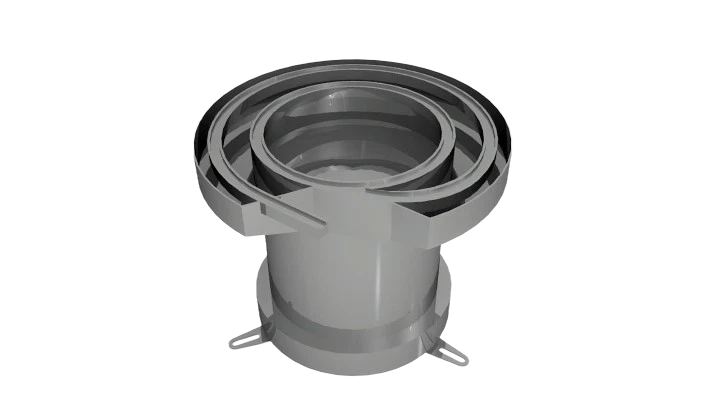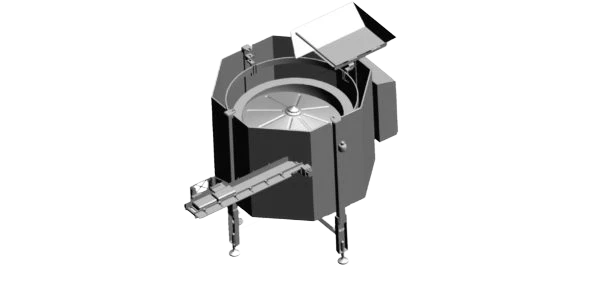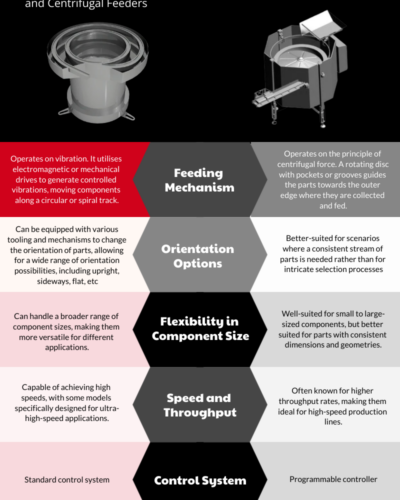In the fast-paced world of food packaging, efficiency, hygiene, and precision are the hallmarks of success. As manufacturers continually seek to optimise the process of delivering food products to packaging lines, vibratory bowl feeders and centrifugal feeders have emerged as essential automation solutions to enhance productivity and packaging process. The two feeding systems, each with unique advantages, play crucial roles in handling a wide array of food products and packaging materials.
This article explores the applications of vibratory bowl feeders and centrifugal feeders in the food packaging industry, highlighting their importance and how they contribute to operational efficiency and product quality.
Vibratory Bowl Feeders in Food Packaging
Vibratory bowl feeders are one of the most common automated part feeding solutions in production lines. They utilise vibration and gravity to sort and orient parts in a consistent flow towards the packaging line, handling delicate food products, such as snakes, sachets, and confectionary products.
Applications in Food Packaging:
Precision Sorting and Orientation
One of the primary applications of vibratory bowl feeders in the food packaging industry is the precise sorting and orientation of products and packaging components. Whether it’s aligning caps for bottles, positioning snack products for packaging, or orienting forks and spoons for inclusion in ready meals, vibratory bowl feeders can precisely feed and handle those products into the packaging machine while ensuring that products meet stringent quality standards.
Efficient Feeding to Packaging Lines
Vibratory bowl feeders streamline the transfer of food products and packaging materials to various parts of the packaging line. Vibratory bowl feeders are adept at handling and feeding parts into machines for filling, sealing, labelling, or wrapping, ensuring a continuous consistent flow to the packaging machines.
Customisation for Diverse Food Products
Vibratory bowl feeders can be customised with different bowl coatings, shapes, and sizes to handle a variety of food products. Vibratory bowl feeders can be equipped with specialised tooling, like conforming liners and sensors, to accommodate oddly shaped or irregularly sized products. This versatility allows food manufacturers to package a wide range of food products efficiently and consistently.
Centrifugal Feeders in Food Packaging
Centrifugal feeders, also known as rotary feeders, work on a different principle. By rotating a disc at high speed, they use centrifugal force to position and deliver parts at high speeds along the periphery of the feeder bowl, where they are then oriented towards the packaging line. Centrifugal feeders are particularly effective for high-volume packaging operations, and for products that have simple geometry require gentle handling like bottles, caps, cans, jars and other containers.
Applications in Food Packaging:
High-Speed Feeding
Centrifugal feeders offer a continuous, high-speed solution. They are capable of feeding thousands of parts per minute, making them ideal for packaging operations that require rapid throughput, such as snack foods, cereals, nutrition bars, and small packaged goods.
Gentle Handling of Food Products
Despite their speed, centrifugal feeders are designed to handle products gently. They can manage a wide array of food products, from wrapped snacks to delicate confectioneries, without causing damage or altering the product’s integrity, which might pose challenges for vibratory bowl feeders.
Other Applications in Food Packaging
Integration with Inspection Systems
Quality control play a pivotal role in the food packaging industry. Vibratory bowl feeders and centrifugal feeders are often integrated with automated inspection systems to ensure that only products meeting the required quality standards proceed to the next stage of packaging.
This integration of feeding and inspection technology provides an additional layer of quality assurance, minimizing the risk of packaging defective, thus safeguarding consumer health and maintaining brand integrity.
Counting and Batching
Another critical application of feeders in food packaging is in the counting and batching of products. They can be precisely calibrated to count specific numbers of items, facilitating the packaging of exact quantities. This capability is particularly important for products sold in multipacks or assortments, where accuracy in quantity is essential for consumer satisfaction and regulatory compliance.
Enhancing Hygiene and Safety
Food safety and hygiene are critical concerns in the food packaging industry. Both vibratory bowl feeders and centrifugal feeders contribute to maintaining high hygiene standards by minimising direct human contact with food products. Feeders for food products are designed with materials and finishes that comply with food safety regulations, ensuring that handling process does not contaminate the products. Additionally, the automation of handling tasks reduces the risk repetitive strain injuries among workers, contributing to a safer workplace.
Conclusion
In the dynamic food packaging industry, where product variety, speed, and consistency are critical, vibratory bowl feeders and centrifugal feeders offer reliable and efficient automation solutions. By leveraging the capabilities of each feeder type, food manufacturers can optimise their packaging operations, reduce product damage, and maintain consistent output, ultimately delivering high-quality products to consumers.
Read more:
- What is a bowl feeder? How does it work?
- Designing an Efficient Vibratory Bowl Feeder: A Comprehensive Guide
- Bowl Feeder vs. Centrifugal Feeder: Unravelling the Key Similarities and Differences


Infographic
Bowl Feeder vs. Centrifugal Feeder
